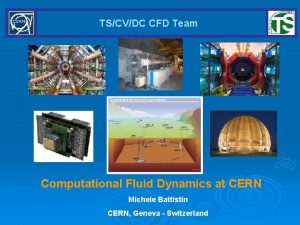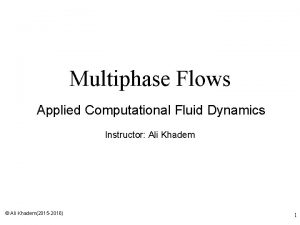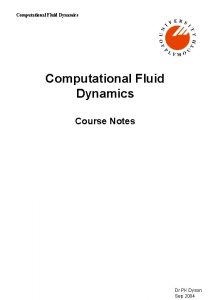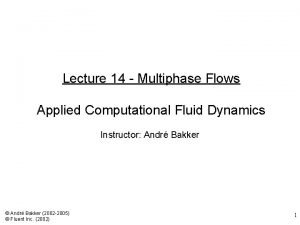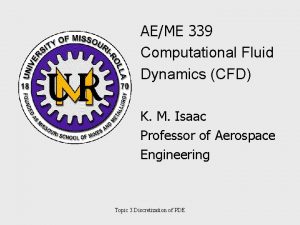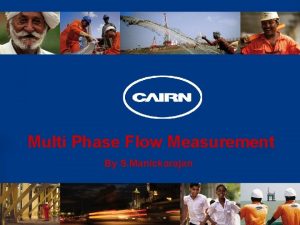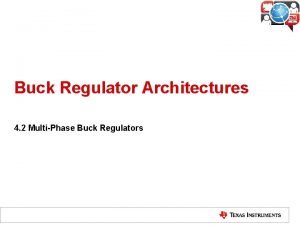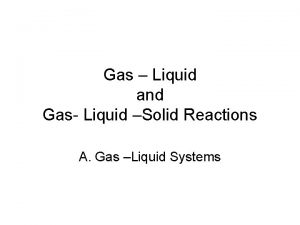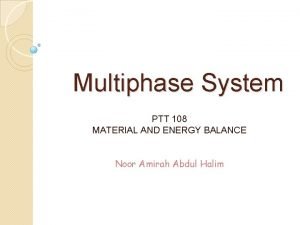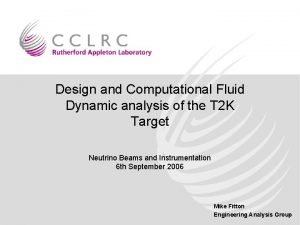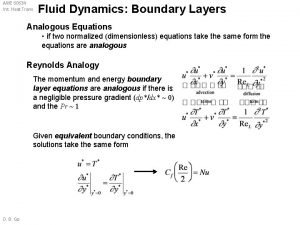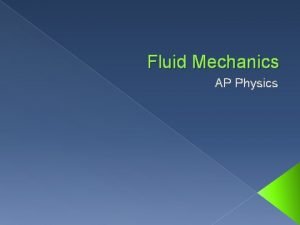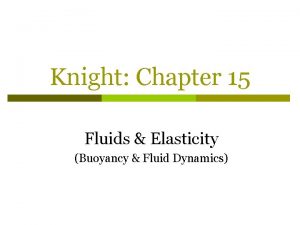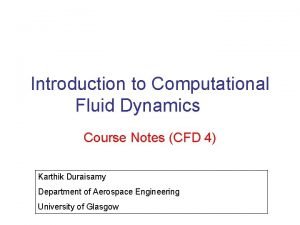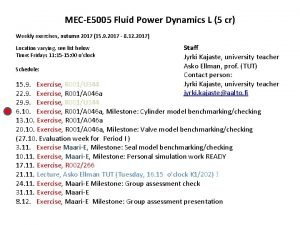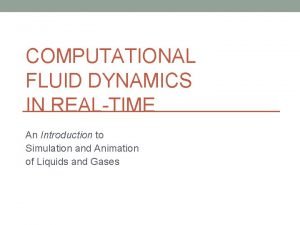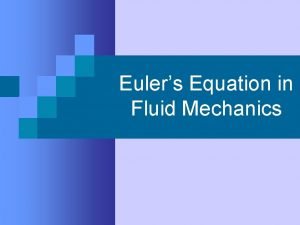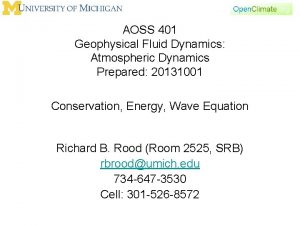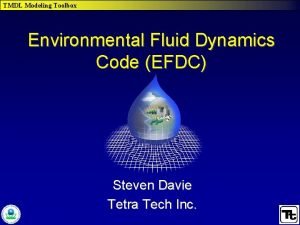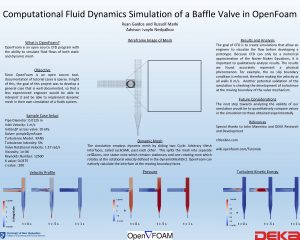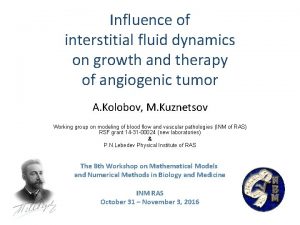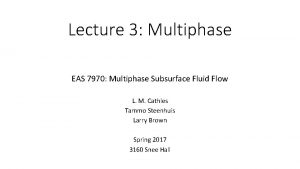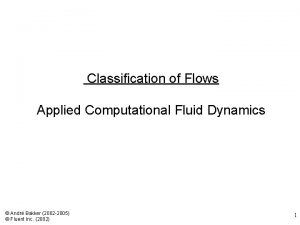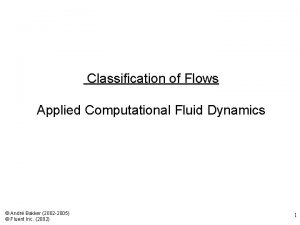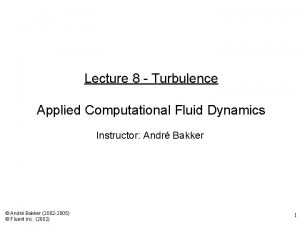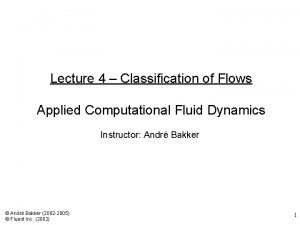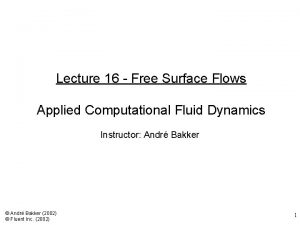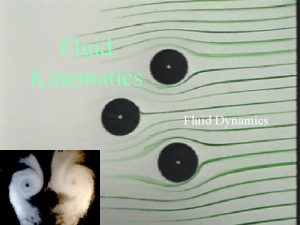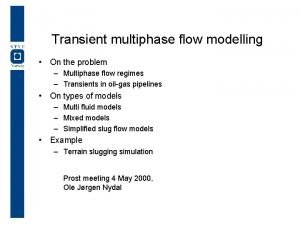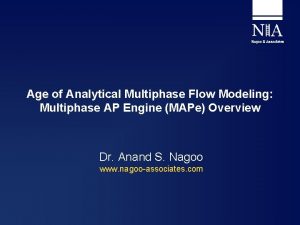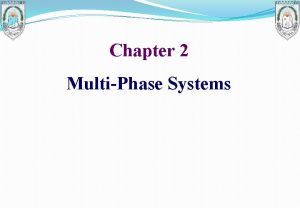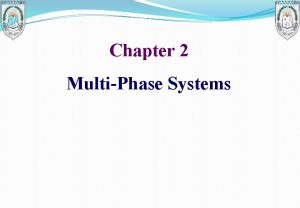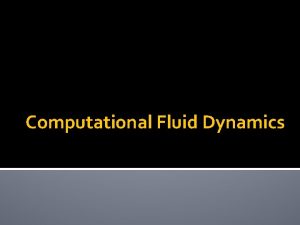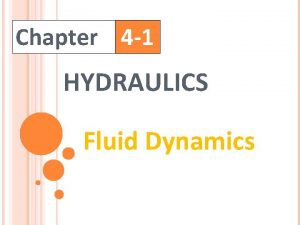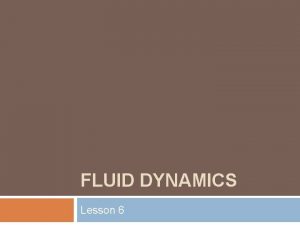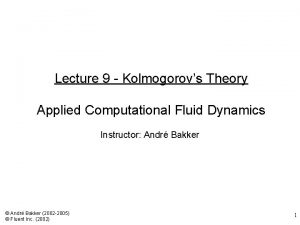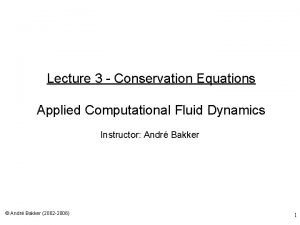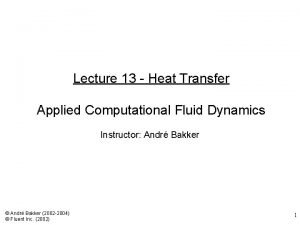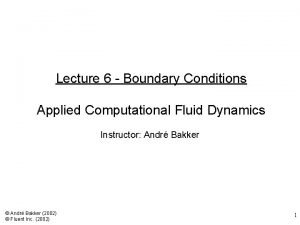Multiphase Flows Applied Computational Fluid Dynamics Instructor Ali
































- Slides: 32

Multiphase Flows Applied Computational Fluid Dynamics Instructor: Ali Khadem © Ali Khadem(2015 -2016) 1

Definitions • Multiphase flow is simultaneous flow of: – Materials with different states or phases (i. e. gas, liquid or solid). – Materials with different chemical properties but in the same state or phase (i. e. liquid-liquid systems such as oil droplets in water). • The primary and secondary phases: – One of the phases is continuous (primary) while the other(s) (secondary) are dispersed within the continuous phase. – A diameter has to be assigned for each secondary phase to calculate its interaction (drag) with the primary phase. – A secondary phase with a particle size distribution is modeled by assigning a separate phase for each particle diameter. 2

Definitions (2) • Dilute versus dense phase: – Refers to the volume fraction of secondary phase(s). • Volume fraction of a phase = Volume of the phase in a cell/domain Volume of the cell/domain • Laminar versus turbulent: – Each phase can be laminar or turbulent. – Fluid flow (primary phase) may be turbulent with respect to the secondary phase but may be laminar with respect to the vessel. 3

Why model multiphase flow? • Multiphase flow is important in many industrial processes: – – Riser reactors. Bubble column reactors. Fluidized bed reactors. Scrubbers, dryers, etc. • Typical objectives of a modeling analysis: – Maximize the contact between the different phases, typically different chemical compounds. – Flow dynamics. Rushton CD-6 BT-6 4

Multiphase flow regimes • Bubbly flow: discrete gaseous bubbles in a continuous liquid. • Droplet flow: discrete fluid droplets in a continuous gas. • Particle-laden flow: discrete solid particles in a continuous fluid. • Slug flow: large bubbles in a continuous liquid. • Annular flow: continuous liquid along walls, gas in core. • Stratified and free-surface flow: immiscible fluids separated by a clearly-defined interface. slug flow annular flow bubbly flow droplet flow particle-laden flow free-surface flow 5

Multiphase flow regimes • • User must know a priori the characteristics of the flow. Flow regime, e. g. bubbly flow, slug flow, annular flow, etc. Only model one flow regime at a time. Predicting the transition from one regime to another possible only if the flow regimes can be predicted by the same model. This is not always the case. • Laminar or turbulent. • Dilute or dense. • Secondary phase diameter for drag considerations. 7

• Empirical correlations. • Lagrangian. – Track individual point particles. – Particles do not interact. • Algebraic slip model. – Dispersed phase in a continuous phase. – Solve one momentum equation for the mixture. Increased complexity Modeling approach • Two-fluids theory (multi-fluids). – Eulerian models. – Solve as many momentum equations as there are phases. • Discrete element method. – Solve the trajectories of individual objects and their collisions, inside a continuous phase. • Fully resolved and coupled. 8

Coupling between phases • One-way coupling: – Fluid phase influences particulate phase via aerodynamic drag and turbulence transfer. – No influence of particulate phase on the gas phase. • Two-way coupling: – Fluid phase influences particulate phase via aerodynamic drag and turbulence transfer. – Particulate phase reduces mean momentum and turbulent kinetic energy in fluid phase. • Four-way coupling: – Includes all two-way coupling. – Particle-particle collisions create particle pressure and viscous stresses. 9

Physical effects in dispersed systems • Hydrodynamics: – – – – Change in shape. Diameter. Particle-wall collision. Particle-particle collision. Coalescence. Dispersion and breakup. Turbulence. Inversion. • Other transport phenomena: – – Heat transfer. Mass transfer. Change in composition. Heterogeneous reactions. 11

Multiphase formulation • Two phases Fluid Solids • Three phases Fluid Solids - 1 Solids - 2 14

Algebraic slip model (ASM) • Solves one set of momentum equations for the mass averaged velocity and tracks volume fraction of each fluid throughout domain. • Assumes an empirically derived relation for the relative velocity of the phases. • For turbulent flows, single set of turbulence transport equations solved. • This approach works well for flow fields where both phases generally flow in the same direction. 16

Example: bubble column design Gas A bubble column is a liquid pool sparged by a process stream. Liquid 2 < L/D < 20 UG, sup up to 50 cm/s Liquid Pool UG, sup >> UL, sup Sparger Liquid/Slurry Inlet Gas Inlet 21

Bubble columns: flow regimes Bubbly Flow Churn-Turbulent Flow (“Heterogeneous”) Flow Regime Map (Deckwer, 1980) 22

Bubble column design issues • Design parameters: – Gas holdup. Directly related to rise velocity. Correlations of the form a ~ usgarlbscmld are commonly used. – Mass transfer coefficient kla. Correlations of the form kla ~ usgarlbscmld mge. Df. Drg are commonly used. – Axial dispersion occurs in both the liquid and gas phase, and correlations for each are available. – Mixing time. Correlations are available for a limited number of systems. – Volume, flow rates and residence time. – Flow regime: homogeneous, heterogeneous, slug flow. 23

Bubble column design issues - cont’d • Accurate knowledge of the physical properties is important, especially the effects of coalescence and mass transfer affecting chemicals. • Although good correlations are available for commonly studied air -water systems, these are limited to the ranges studied. • Correlations may not be available for large scale systems or systems with vessel geometries other than cylinders without internals. • Furthermore, experimental correlations may not accurately reflect changes in performance when flow regime transitions occur. 24

Bubble column example - ASM • 3 D modeling of dynamic behavior of an air-water churn turbulent bubble-column using the ASM model. • This model solves only one momentum equation for the gasliquid mixture. • Constant bubble size is used. Iso-contours of gas volume fraction 27

Bubble column example - ASM Unstable flow in a 3 -D bubble column with rectangular cross section. 28

Example - gas-liquid mixing vessel • Combinations of multiple impeller types used. • Bottom radial flow turbine disperses the gas. • Top hydrofoil impeller provides good blending performance in tall vessels. Eulerian Gas-Liquid Simulation Animation 29

Fluidized-bed systems • When a fluid flows upward through a bed of solids, beyond a certain fluid velocity the solids become suspended. The suspended solids: – has many of the properties of a fluid, – seeks its own level (“bed height”), – assumes the shape of the containing vessel. • Bed height typically varies between 0. 3 m and 15 m. • Particle sizes vary between 1 mm and 6 cm. Very small particles can agglomerate. Particle sizes between 10 mm and 150 mm typically result in the best fluidization and the least formation of large bubbles. Addition of finer size particles to a bed with coarse particles usually improves fluidization. • Superficial gas velocities (based on cross sectional area of empty bed) typically range from 0. 15 m/s to 6 m/s. 32

Fluidized bed example 33

Fluidized bed uses • Fluidized beds are generally used for gas-solid contacting. Typical uses include: – Chemical reactions: • Catalytic reactions (e. g. hydrocarbon cracking). • Noncatalytic reactions (both homogeneous and heterogeneous). – Physical contacting: • Heat transfer: to and from fluidized bed; between gases and solids; temperature control; between points in bed. • Solids mixing. • Gas mixing. • Drying (solids or gases). • Size enlargement or reduction. • Classification (removal of fines from gas or fines from solids). • Adsorption-desorption. • Heat treatment. • Coating. 34

Typical fluidized bed systems - 1 Gas and entrained solids Solids Feed Disengaging Space (may also contain a cyclone separator) Freeboard Dust Separator Fluidized Bed depth Dust Gas in Solids Discharge Windbox or plenum chamber Gas distributor or constriction plate 35

Typical fluidized bed systems - 2 Gas + solids Riser section of a recirculating fluidized bed Solids Gas Bed with central jet Uniform Fluidization 36

Fluidization regimes Umf Uch Umb Solids Return U Gas Fixed Bed Particulate Regime Bubbling Regime Slug Flow Regime Turbulent Regime Fast Fluidization Pneumatic Conveying Increasing Gas Velocity 37

Fluidized bed design parameters • Main components are the fluidization vessel (bed portion, disengagement space, gas distributor), solids feeder, flow control, solids discharge, dust separator, instrumentation, gas supply. • There is no single design methodology that works for all applications. The design methodologies to be used depend on the application. • Typical design parameters are bed height (depends on gas contact time, solids retention time, L/D for staging, space required for internal components such as heat exchangers). • Flow regimes: bubbling, turbulent, recirculating, slugs. Flow regime changes can affect scale-up. • Heat transfer and flow around heat exchanger components. • Temperature and pressure control. • Location of instrumentation, probes, solids feed, and discharges. 38

Fluidized bed - input required for CFD • CFD can not be used to predict the: – minimum fluidization velocity, – and the minimum bubbling velocity. • These depend on the: – – particle shape, particle surface roughness, particle cohesiveness, and the particle size distribution. • All of these effects are lumped into the drag term. Hence we need to fine tune the drag term to match the experimental data for minimum fluidization or minimum bubbling velocity. 39

Fluidized bed - when to use CFD • If the drag term is tuned to match the minimum fluidization velocity, CFD then can be used to predict: – – bed expansion gas flow pattern solid flow pattern bubbling size, frequency and population – short circuiting – effects of internals – – – – effects of inlet and outlets hot spots reaction and conversion rates mixing of multiple particle size residence times of solids and gases backmixing and downflows (in risers) solids distribution/segregation 40

Fluidized bed animation VOF of gas Vs = 6 cm/s 41

Bubble size and shape - validation Gidaspow (1994) 42

Conclusion • Today discussed the: – The algebraic slip model solves one momentum equation for the mixture. – Eulerian model solves one momentum equation per phase. 45

References • 1943 Dumitrescu, DT: "Strömung an einer Luftblase in senkrecthen Rohr" Z. angew. Math. Mech. , 1943, vol. 23, no. 3, pp 139 -149 • 1950 Davis, R. M. , Taylor, G. I. : "The Mechanics of Large Bubbles Rising Trough Extended Liquids and Through Liquids in tubes " Proc. Royal Soc. , London, vol. 200 series A, 1950, pp 375 -390. • 1955 Hinze, J. O. : "Fundamentals of the Hydro Dynamic Mechanisms of Splitting in Dispersion Processes ", AICHE J. (Vol 1, No. 3), 1995, pp 289 -295 • 1960 Harmathy, T. Z. : "Velocity of Large Drops and Bubbles in Media Of Infinite or Restricted Extend " AICHE, no. 6, p. 281, 1960. • 1962 Nicklin, DJ, Wilkes, JO, Davidson, JF: "Two Phase Flow in Vertical tubes" Trans. Instn. Chem. Engrs. Vol 40, 1962, pp 61 -68. • 1965 Zuber, N. & Finlay, J. : "Average volumetric concentration in two-phase flow systems" Trans ASME, J. Heat Transfer. C 87, 453 -468 • 1966 Zukoski, EE: "Influence of viscosity, surface tension and inclination Wednesday angle motion of long bubbles in closed tubes " Journet. of Fluid Mechanics 1996, vol. 25, p. 4, pp 821 -837. 46

• 1974 Ashford, FE: "An Evaluation of Critical Multi-Phase Flow Performance Through Well Head Chokers " JPT, Aug. 1974, p. 843. • 1976 Taitel, Y. , Dukla, A. E. : "A Model for predicting Flow Regime Transitions in Horizontal and Near Horizontal Gas-Liquid Flow " AICHE Journet. , Vol 22, No. 1, Jan. 1976, pp 47 -55. • 1976 Campbell, JM: Gas Conditioning and Processing. (Vol 1) Campbell Petroleum Series, 121 Collier Drive, Norman, OK • 1977 Kubi, J. , Gardner, GC: "Drop sizes and Drop Dispersion in Straight Horizontal tubes and Helical Coil " Chem. Engr. Sci. , Vol 32, 1977, pp 195 -202. • 1978 Karabelas, A. J. "Droplets Size Spectra Generated in turbulent Pipe Flow-Dilute of Liquid / Liquid Dispersions " AICHE Journal, Vol 24, No. 2, March 1978, p 170 • 1986 Asheim, H. : "MONA, An Accurate Two-Phase Well Flow Model Based on Phase Slip Page" SPE Production Engineering, May 1986, pp 221 -230 • 1990 Kabir, C. S. and Hasan, A. R. : "Performance of two-phase gas / liquid flow model in vertical wells" J. of Petroleum Sci. and Engr, 4, 1990, 273 • 1991 Basniev, K. S. & Many others: "Thermal Dynamic model for the provision of the flow capacity of gas wells" (in Russian) Gasprom 1991 • Best Regards 47
 Cern alice
Cern alice Computational fluid dynamics
Computational fluid dynamics Fluid dynamics
Fluid dynamics Computational fluid dynamics
Computational fluid dynamics Computational fluid dynamics
Computational fluid dynamics Sutherland's law
Sutherland's law Mpm multiphase flow meter
Mpm multiphase flow meter Multiphase buck
Multiphase buck Solid gas liquid
Solid gas liquid Multiphase system example
Multiphase system example Multiphase flow meter
Multiphase flow meter Multiphase iterative design
Multiphase iterative design Computational fluid dynamic
Computational fluid dynamic How does water go through your body
How does water go through your body Fluid thrill amount
Fluid thrill amount Synovial fluid
Synovial fluid Interstitial fluid vs extracellular fluid
Interstitial fluid vs extracellular fluid Fluid statics deals with fluid at rest
Fluid statics deals with fluid at rest P1-p2
P1-p2 Fluid kinematics is part of fluid mechanics in which
Fluid kinematics is part of fluid mechanics in which Transcellular fluid compartment
Transcellular fluid compartment Movement of body fluids
Movement of body fluids Fluid dynamics
Fluid dynamics Fluid dynamics
Fluid dynamics Fluid dynamics
Fluid dynamics Fluid dynamics notes
Fluid dynamics notes Fluid power dynamics
Fluid power dynamics Fluid dynamics animation
Fluid dynamics animation Euler's equation
Euler's equation Geophysical fluid dynamics
Geophysical fluid dynamics Environmental fluid dynamics code
Environmental fluid dynamics code Openfoam baffle
Openfoam baffle Fluid dynamics
Fluid dynamics
